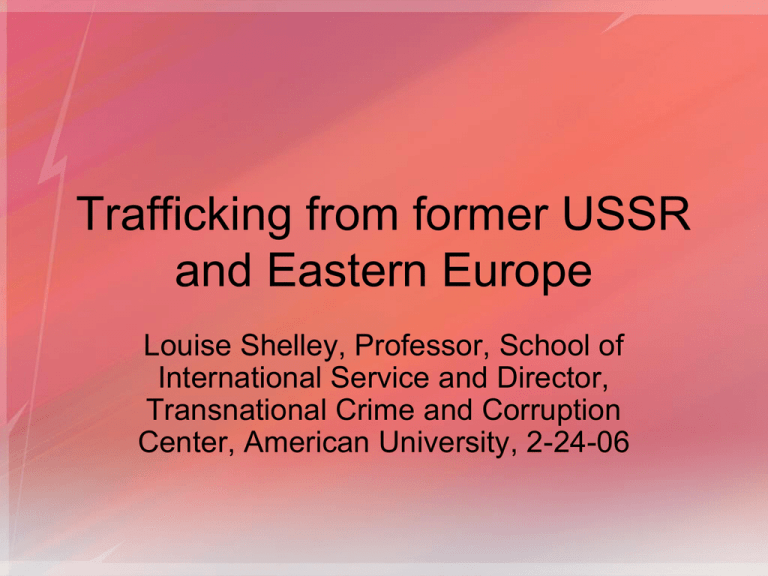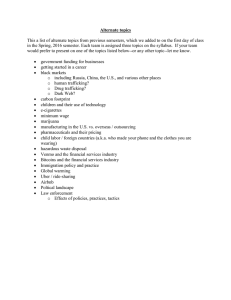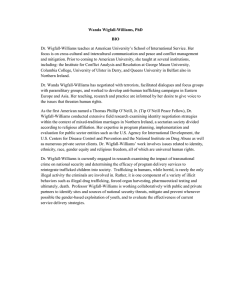
Trafficking from former USSR
and Eastern Europe
Louise Shelley, Professor, School of
International Service and Director,
Transnational Crime and Corruption
Center, American University, 2-24-06
TRAFFICKING: DEFINITION
• The trafficking of human beings is the
recruitment, transportation, transfer,
harbouring or receipt of people for the
purpose of exploitation. Trafficking
involves a process of using illicit means
such as threat, use of force, or other forms
of coercion, of abduction, of fraud, of
deception, of the abuse of power or of a
position of vulnerability.
DEFINITION (cont.)
• Exploitation includes forcing people into
prostitution or other forms of sexual exploitation,
forced labour or services, slavery or practices
similar to slavery, servitude or the removal of
organs. For children exploitation may include
also, illicit international adoption, trafficking for
early marriage, recruitment as child soldiers, for
begging or for sports (such as child camel
jockeys or football players), or for recruitment for
religious cults.
Diversity of Phenomenon
• Countries Span geographically from borders of
European Union, across Asia to the Far East
• Involves sexual trafficking for sexual exploitation, labor,
adoption, trafficking of children for begging
• Families that are sources of trafficking victims range
from nuclear family to large extended family
• Range from European societies to traditional societies of
Central Asia
• Different religious backgrounds and traditions that affect
destinations
Common Features
• Socialist Past and Tradition of Social Welfare
Benefits for women and children and guaranteed
employment
• Lack for respect for human rights
• Absence of rule of law
• Centrality of organized crime groups—both large
and small in this phenomenon
• Extreme use of violence towards victims
• Feminization of poverty
• Inability of states to control separatist regions
Distinctive Features of Trafficking
from this Region
• Victims of trafficking tend to be much more
educated than from other regions of the world,
often with high school education
• Relatively new phenomenon since the collapse
of socialism
• Economic collapse of the region provided steady
supply of individuals (male and female) to be
trafficked
• Labor migrants who fall into exploitation from
Central Asia can be intellectual elite of country
Distinctive Features of Trafficking
from this Region cont.
• Enormous geographic spread of the
victimization—to Western Europe, US, Asia and
even Latin America
• Business side of this phenomenon is resource
exploitation model rather than long term
business, profits do not fuel development but
dissipated or subject to conspicuous
consumption
• Crime groups more involved with human
trafficking than with drug trade in initial stages of
their rise
Features in Common with
Trafficking Elsewhere
• Corruption is central element of ability to move
victims
• Recruitment occurs through acquaintances and
sometimes friends and family members
• Trafficking is highest in regions with conflicts and
in post-conflict regions—former Yugoslavia,
Transdniester, Tajikistan
• Significant involvement of all forms of organized
crime
• Draws on economically vulnerable populations
Economic Factors Precipitating
Trafficking
• Economic collapse of these societies after
the end of socialism and regional conflicts
• With advent of privatization, enormous
disparities of wealth and income in
societies which once had ideological
commitment to equality
• Absence of social safety net made citizens
to seek any way to support families
Economic Factors Precipitating
Trafficking cont.
• Loss of savings through corruption and lack of
regulation of banking sector
• Economic advisors to make economic system
more efficient advised countries to drop social
welfare support at factories without providing
substitute
• Failure of international advisors to acknowledge
the central economic role of trafficking and labor
migration
• Enormous corruption of top leadership in former
Soviet Union countries has deprived citizens of
resources from the state
Persistence of the Phenomenon
• Trafficking continues despite accession of many
countries to EU and improving economic situation in
Russia and Ukraine
• Russia and Ukraine are increasingly becoming host
countries for labor trafficking from Central Asia and Asia
and sexual trafficking from poorer countries
• Crime groups are so entrenched in Baltics, former
Yugoslavia and parts of Eastern Europe that trafficking
persists despite the economic improvement and
increased border controls
• Lack of labor protections allows persistence of labor
trafficking even if it is evident to public
Demand for the Trafficked
Individuals
• Sexual demand in Western Europe,
Middle East, US and Asia
• Clients seeking more educated and
younger women than are usually available
• Cheap labor demand in economically
developing former socialist countries—i.e.
Russia, Poland, Ukraine
• Children are trafficked to families wanting
children
Trafficking into the US
• Sexual trafficking into many parts of the US—
cases from this region have been in Northeast,
Detroit, California, Alaska, Florida
• Labor trafficking from Central Asia
• Organized Crime involvement and small scale
entrepreneurship
• Little success in tracing profits of crime groups
• Very few cases compared to the size of the
phenomenon even after TIP legislation
Trafficking into U.S. cont.
• Involves corruption not only in socialist countries
but American institutions, i.e. consular offices
• Limited repatriation of victims or T-visas
• Victims are often frightened because victim
protection programs are not working as needed
because of transnational nature of crime groups
• Advertising of trafficking goes on through yellow
pages and newspapers and more could be done
through greater control of private sector






